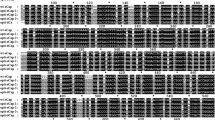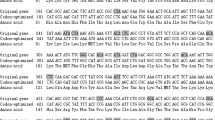Abstract
Three pairs of specific primers were designed to amplify the F2-1, F2-2 and XF2-2 truncated sequences of ORF2 which encodes the capsid protein of porcine circovirus type 2 (PCV-2). The F2-1 sequence had most of the NLS region of ORF2, but the F2-2 and XF2-2 genes had the NLS region deleted. Truncated genes were subcloned into pET-32a(+) vectors to construct recombinant fusion expression vectors. The vectors were then transformed into Rosetta(DE3) E. coli and expressed by induction of IPTG. Expressed proteins were detected by western blotting and ELISA. The protein with best immunoreactivity was confirmed and selected, then utilized to inoculate SPF rabbits to prepare polyclonal antibodies. The protein and prepared polyclonal antibody were utilized to detect sera samples against PCV-2 from Shandong province and PCV-2 particles in PK-15 cells. In our study, three recombinant fusion proteins were successfully obtained, and the molecular weights of fusion proteins were 35.9 kDa, 33.6 kDa and 38.6 kDa respectively detected by SDS-PAGE. All of the proteins showed positive reaction with anti-PCV-2 antisera, and His-XF2-2 showed better immunoreactivity than the others. The protein of His-XF2-2 was coated as antigen in ELISA to detect the seroprevalence of PCV-2 in certain districts of Shandong province, the seropositivity rate was 27.7 % (73/264). Specific fluorescence and positive signals for PCV-2 could be detected in PK-15 cells inoculated with PCV-2 with the participation of prepared antibodies against His-XF2-2 in IFA and IPMA. Experimental results indicated that the truncated PCV-2 ORF2 gene containing most of the NLS region was successfully expressed in E. coli, and His-XF2-2 was demonstrated to have better immunoreactivity with anti-PCV-2 antisera than the other two fusion proteins. His-XF2-2 and prepared polyclonal antibodies against it had a satisfactory capability in detecting PCV-2 infection.
Similar content being viewed by others
References
Allan G M, McNeilly F, Kennedy S, et al. 1998. Isolation of porcine circovirus-like viruses from pigs with a wasting disease in the USA and Europe. J Vet Diagn Invest, 10:3–10.
Blanchard P, Mahe D, Cariolet R, et al. 2003. An ORF2 protein-based ELISA for porcine circovirus type 2 antibodies in post-weaning multisystemic wasting syndrome. Vet Microbiol, 94:183–194.
Bradford M M. 1976. A rapid and sensitive method for the quantitation of microgram quantities of protein utilizing the principle of protein-dye binding. Anal Biochem, 72:248–254.
Chae C. 2005. A review of porcine circovirus 2-associated syndromes and diseases. Vet J, 169:326–336.
Ellis J, Hassard L, Clark E, et al. 1998. Isolation of circovirus from lesions of pigs with postweaning multisystemic wasting syndrome. Can Vet J, 39:44–51.
Kim J, Chung H K, Chae C. 2003. Association of porcine circovirus 2 with porcine respiratory disease complex. Vet J, 166:251–256.
Lekcharoensuk P, Morozov I, Paul P S, et al. 2004. Epitope mapping of the major capsid protein of type 2 porcine circovirus (PCV2) by using chimeric PCV1 and PCV2. J Virol, 78:8135–8145.
Liu C, Ihara T, Nunoya T, et al. 2004. Development of an ELISA based on the baculovirus-expressed capsid protein of porcine circovirus type 2 as antigen. J Vet Med Sci, 66:237–242.
Liu Q, Tikoo S K, Babiuk L A. 2001. Nuclear localization of the ORF2 protein encoded by porcine circovirus type 2. Virology, 285:91–99.
Liu Q, Willson P, Attoh-Poku S, et al. 2001. Bacterial expression of an immunologically reactive PCV2 ORF2 fusion protein. Protein Expr Purif, 21:115–120.
Mahe D, Blanchard P, Truong C, et al. 2000. Differential recognition of ORF2 protein from type 1 and type 2 porcine circoviruses and identification of immunorelevant epitopes. J Gen Virol, 81:1815–1824.
Mankertz A, Mankertz J, Wolf K, et al. 1998. Identification of a protein essential for replication of porcine circovirus. J Gen Virol, 79( Pt 2):381–384.
Nawagitgul P, Harms P A, Morozov I, et al. 2002. Modified indirect porcine circovirus (PCV) type 2-based and recombinant capsid protein (ORF2)-based enzyme-linked immunosorbent assays for detection of antibodies to PCV. Clin Diagn Lab Immunol, 9:33–40.
Nawagitgul P, Morozov I, Bolin S R, et al. 2000. Open reading frame 2 of porcine circovirus type 2 encodes a major capsid protein. J Gen Virol, 81:2281–2287.
Opriessnig T, Meng X J, Halbur P G. 2007. Porcine circovirus type 2 associated disease: update on current terminology, clinical manifestations, pathogenesis, diagnosis, and intervention strategies. J Vet Diagn Invest, 19:591–615.
Rosell C, Segales J, Ramos-Vara J A, et al. 2000. Identification of porcine circovirus in tissues of pigs with porcine dermatitis and nephropathy syndrome. Vet Rec, 146:40–43.
Shang S B, Li Y F, Guo J Q, et al. 2008. Development and validation of a recombinant capsid protein-based ELISA for detection of antibody to porcine circovirus type 2. Res Vet Sci, 84:150–157.
Trundova M, Celer V. 2007. Expression of porcine circovirus 2 ORF2 gene requires codon optimized E. coli cells. Virus Genes, 34:199–204.
Wattrang E, McNeilly F, Allan G M, et al. 2002. Exudative epidermitis and porcine circovirus-2 infection in a Swedish SPF-herd. Vet Microbiol, 86:281–293.
Wu P C, Chien M S, Tseng Y Y, et al. (2008) Expression of the porcine circovirus type 2 capsid protein subunits and application to an indirect ELISA. J Biotechnol, 133:58–64.
Zhou J Y, Shang S B, Gong H, et al. 2005, In vitro expression, monoclonal antibody and bioactivity for capsid protein of porcine circovirus type II without nuclear localization signal. J Biotechnol, 118:201–211.
Author information
Authors and Affiliations
Corresponding author
Additional information
Foundation item: This work was supported by the special studies for social welfare researches in institutes (2005DIB4J041)
Rights and permissions
About this article
Cite this article
Lou, Zz., Li, Zy., Wang, G. et al. Prokaryotic expression and potential application of the truncated PCV-2 capsid protein. Virol. Sin. 25, 86–97 (2010). https://doi.org/10.1007/s12250-010-3111-7
Received:
Accepted:
Published:
Issue Date:
DOI: https://doi.org/10.1007/s12250-010-3111-7




